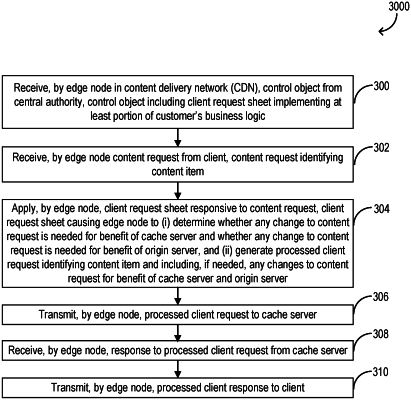| CPC H04L 67/568 (2022.05) [G06F 15/17331 (2013.01); H04L 63/083 (2013.01); H04L 67/10 (2013.01)] | 13 Claims |

|
1. A computer-implemented method for standardizing content requests and responses in a content delivery network (CDN), the computer-implemented method comprising:
receiving, by an edge node, a control object from a central authority, the control object comprising a client request sheet implementing at least a portion of a customer's business logic and an origin response sheet implementing at least a portion of the customer's business logic;
receiving, by the edge node, a content request from a client, the content request identifying a content item;
applying, by the edge node, the client request sheet responsive to the content request, the client request sheet causing the edge node to (i) determine any change to the content request is needed for the benefit of a cache server and any change to the content request is needed for the benefit of an origin server, and (ii) generate a processed client request identifying the content item and including any changes to the content request for the benefit of the cache server and the origin server;
transmitting, by the edge node, the processed client request to the cache server;
receiving, by the edge node, a response to the processed client request from the cache server;
transmitting, by the edge node, the processed client response to the client;
receiving, by a downstream computer, the origin response sheet;
applying, by the downstream computer, the origin response sheet responsive to the origin response, the origin response sheet causing that node to (i) determine any change to the origin response is needed for the benefit of the cache server and (ii) generate a processed origin response including the content item and any changes to the origin response for the benefit of the cache server;
receiving, by the cache server, the processed origin response;
transmitting to the edge node a cached processed origin response,
wherein the client request sheet further causes the edge node to (i) authenticate the client and (ii) indicate in the processed client request that the client is authenticated,
wherein, based on the processed client request indicating that the client is authenticated, neither the cache server nor the origin server performs an additional authentication of the client, and
wherein the cached processed origin response is identical to the processed origin response.
|